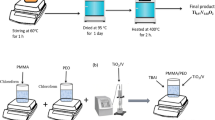Abstract
Binary polymer blends that can form hydrogen-bond networks were prepared and used to fabricate the guest-host organic electro-optic (EO) materials. The hydrogen-bonds network in the solid films of novel guest-host organic EO materials was verified by FT-IR spectra. After corona poling, two kinds of EO films revealed the maximum EO coefficient value (r 33) of 19.5 and 30 pm/V at the wavelength of 1310 nm. The EO activity and the order parameter of the chromophores in the poled films both indicated that the hydrogen-bond network has little impact on the motion of the chromophores while poling. These new EO films exhibited better temporal stability after 250 h at 55 and 85 °C compared with the conventional guest-host systems that have the similar or higher T gs. Moreover, the results also indicated that polymer blends as the host of EO materials can change the dielectric strength of the materials, which directly influence the poling efficiency.
Similar content being viewed by others
References
Burland DM, Miller RD, Walsh CA. Second-order nonlinearity in poled-polymer systems. Chem Rev, 1994, 94(1): 31–75
Dalton LR. Rational design of organic electro-optic materials. J Phys-Condens Mat, 2003, 15(20): R897–R934
Dalton LR, Sullivan PA, Bale DH. Electric field poled organic electro-optic materials: State of the art and future prospects. Chem Rev, 2010, 110(1): 25–55
Hao JM, Han MJ, Guo KP, Zhao YX, Qiu L, Shen YQ, Meng XG. A novel NLO azothiophene-based chromophore: Synthesis, characterization, thermal stability and optical nonlinearity. Mater Lett, 2008, 62(6–7): 973–976
Kim TD, Luo JD, Cheng YJ, Shi ZW, Hau S, Jang SH, Zhou XH, Tian Y, Polishak B, Huang S, Ma H, Dalton LR, Jen AKY. Binary chromophore systems in nonlinear optical dendrimers and polymers for large electrooptic activities. J Phys Chem C, 2008, 112(21): 8091–8098
Lee JY, Bang HB, Park EJ, Rhee BK, Lee SM, Lee JH. Molecular design, synthesis, and nonlinear optical properties of novel t-type polyimides with exceptionally high thermal stability of the second harmonic generation. J Polym Sci Part A-Polym Chem, 2004, 42(13): 3189–3199
Luo JD, Haller M, Li HX, Tang HZ, Jen AKY, Jakka K, Chou CH, Shu CF. A side-chain dendronized nonlinear optical polyimide with large and thermally stable electrooptic activity. Macromolecules, 2004, 37(2): 248–250
Chen WC, Kuo SW, Jeng US, Chang FC. Self-assembly through competitive interactions of miscible diblock copolymer/homopolymer blends: Poly(vinylphenol-b-methyl methacrylate)/poly(vinylpyrrolidone) blend. Macromolecules, 2008, 41(4): 1401–1410
Kuo SW, Tsai HT. Complementary multiple hydrogen-bonding interactions increase the glass transition temperatures to pmma copolymer mixtures. Macromolecules, 2009, 42(13): 4701–4711
Yang Z, Han CD. Rheology of miscible polymer blends with hydrogen bonding. Macromolecules, 2008, 41(6): 2104–2118
Gao JK, Cui YJ, Yu JC, Lin WX, Wang ZY, Qian GD. A 3-phenoxypropane-1, 2-diol based bichromophore for enhanced nonlinear optical properties. Dyes Pigments, 2010, 87(3): 204–208
Chen Z, Gao W, Li XD, Zhen Z, Liu XH. Synthesis of dendronized NLO chromophores and research on electro-optic properties of its polymer systems. Chem J Chin U, 2010, 31(7): 1369–1374
Teng CC, Man HT. Simple reflection technique for measuring the electrooptic coefficient of poled polymers. Appl Phys Lett, 1990, 56(18): 1734–1736
Lee JY, Painter PC, Coleman MM. Hydrogen-bonding in polymer blends. 4. Blends involving polymers containing methacrylic-acid and vinylpyridine groups. Macromolecules, 1988, 21(4): 954–960
Lee LT, Woo EM, Hou SS, Forster S. Miscibility with positive deviation in t-g-composition relationship in blends of poly(2-vinyl pyridine)-block-poly(ethylene oxide) and poly(p-vinyl phenol). Polymer, 2006, 47(25): 8350–8359
Mortazavi MA, Knoesen A, Kowel ST, Higgins BG, Dienes A. 2nd-harmonic generation and absorption studies of polymer dye films oriented by corona-onset poling at elevated-temperatures. J Opt Soc Am B, 1989, 6(4): 733–741
Grote JG, Zetts JS, Nelson RL, Hopkins FK. Conductive cladding layers for electrode poled nonlinear optic polymer electro-optics. Secondary conductive cladding layers for electrode poled nonlinear optic polymer electro-optics. In: Proceedings of SPIE. Bellingham, 2000, 4114: 101–109
Author information
Authors and Affiliations
Corresponding author
Electronic supplementary material
Rights and permissions
About this article
Cite this article
Deng, G., Bo, S., Zhou, T. et al. Hydrogen-bonded network: An effective approach to improve the thermal stability of organic/polymer electro-optic materials. Sci. China Chem. 56, 169–173 (2013). https://doi.org/10.1007/s11426-012-4799-z
Received:
Accepted:
Published:
Issue Date:
DOI: https://doi.org/10.1007/s11426-012-4799-z




